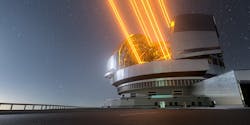The Extremely Large Telescope (ELT) that is being built by European Southern Observatory's (ESO; Garching, Germany) could use up to eight guide star laser systems. With “first light” for the telescope expected in the second half of the “twenties”, ESO appears on schedule to deliver the remaining lasers for the next-generation super telescope.
The guide star lasers for the adaptive optics system on the ELT are based on the laser systems that have successfully operated at the Very Large Telescope (VLT) since 2016 as part of the Adaptive Optics Facility (AOF), which has shown spectacular improvements in image sharpness.
Adaptive optics compensate for the blurring effect of the Earth’s atmosphere, enabling astronomers to obtain much sharper images. Lasers create multiple artificial guide stars high in the Earth’s atmosphere. These points of light, used as reference light sources, allow the adaptive optics system to compensate for turbulence in the Earth’s atmosphere.
Unlike natural guide stars, laser guide stars can be positioned anywhere to allow the full power of adaptive optics to be used over almost the entire sky. The ELT will employ incredibly sophisticated 'adaptive optics' technologies to ensure its images are sharper than those of any other telescope. Anticipated observations enabled by the ELT’s powerful built-in adaptive optics system include everything from studying black holes to investigating some of the youngest galaxies in the distant universe.
TOPTICA Projects GmbH, home of award-winning Guide Star laser activities with applications in astronomical adaptive optics, space situational awareness and satellite communications, was founded in 2016 by TOPTICA Photonics in order to serve high complexity laser projects more efficiently. These lasers deliver more than 20 W of single-frequency output at the sodium resonance of 589 nm and already provide outstanding performance at most of the major ground-based observatories worldwide.
The SodiumStar and its team have been rewarded with the 2016 Laser Research Innovation Award presented by the Berthold Leibinger Stiftung and the 2017 Paul F. Forman Team Engineering Excellence Award of the Optical Society of America.
